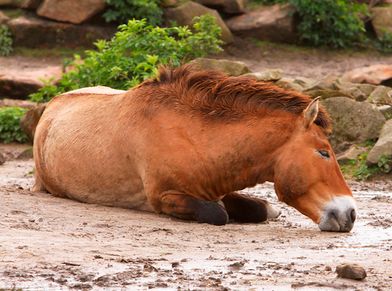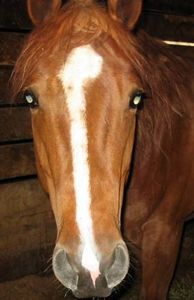 How to Check if Your Horse or Pony has Severe Brain or Head Trauma
How to Check if Your Horse or Pony has Severe Brain or Head Trauma
Today, I’m going to give you 3 simple field tests you can perform with your horse in the field. When you learn them, you’ll be able to tell the difference between a minor horse head injury and a real veterinary emergency. You don’t have to be an equine vet to use them. And they could save your horse’s life.
The first 24 hours after a head injury are the most critical. If your horse has, indeed, injured his brain, the next 24 will be the time he’ll show symptoms. That’s why you’ll want to spend as much time with in your horse’s presence during this period as you can.
During this time, you can run a few simple tests to check your horse for a possible brain injury. These are easy observations. You don’t have to be a vet to perform them. Nor do you need any special equipment other than what you probably already have in your own barn.
Before I tell you what they are, I want to give you one important note: if your horse has had a head injury and he is
lying down, don’t try to force him to get up. If he attempts it on his own, that’s a good sign, but don’t help him. Even though you desparately want to.
Remember, he’s 10-20 times your weight, and if he does have a brain injury, he may panic, go into convulsions, and become agitated at his inability to stand up. If that happens, he may lose his balance, and fall over on top of you. Then you’ll have 2 injuries to deal with – his and yours, too.
So if you’re on site with your horse who has had a head injury, here’s what to do (and what not to do):
 *Vision Test: Hold up one finger about 8 inches away from your horse’s eye. Move it back and forth. If he follows your finger with his eye, you at least know he can still see and his brain is reacting to an external stimulus. This is a good thing.
*Vision Test: Hold up one finger about 8 inches away from your horse’s eye. Move it back and forth. If he follows your finger with his eye, you at least know he can still see and his brain is reacting to an external stimulus. This is a good thing.
*Mobility Test: Do this ONLY if he’s already standing. Try to get him to follow you. Horses are herd animals by nature, so this instinct should kick in without his thinking about it. If he does follow you, that’s another good thing. If, however, he can’t put one leg in front of the other without stumbling, that could indicate neurological trauma – call a vet now.
*Consciousness Test: This is perhaps the most important observation you can make. It’s a horse’s nature to be constantly alert for threats from predators. So if your horse is up and alert, he’s probably in no danger at all. If he’s sluggish, but still responds to your handling, he needs to see a vet, but the situation probably isn’t urgent. If, however, he’s comatose and so lethargic that he cannot be aroused, then you do have a medical emergency on your hands. Get a vet out there now.
You’ll also want to check his pupils. When the pupils are really big, we call them dilated. When they’re really small, we call them contracted. You probably already keep a flashlight in your barn. Get one and shine it in your horse’s eyes. His pupils should contract when you do. If they don’t, you’ve got a serious problem, and you need your vet on-site ASAP.
Another indicator is his breathing. If your horse’s breathing becomes very rapid, that is also not a good sign. Call your vet immediately and tell him you’ve got real horse emergency on your hands.
Any of the dangerous signs I’ve described above could mean that your horse has swelling of the brain (the veterinary term is “increased intracranial pressure”). Your horse’s brain box doesn’t allow much room for the brain to swell. So if you your horse fails any of the above tests, you have an emergency situation and you need to take action to save your horse’s life immediately.
Thankfully, horse head injuries seldom result in brain injuries. The brain box offers a lot of protection for your
horse. But if the unthinkable should happen, your knowing the warning signs could save your horse’s life.
About The Author: Sierra Lynch has over 16 years experience riding and caring for horses.